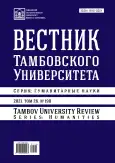Dynamics of students’ physical development indicators in the course of Nordic walking classes
- Authors: Sokolova I.V.1
-
Affiliations:
- St. Petersburg University of Humanities and Social Sciences
- Issue: Vol 26, No 190 (2021)
- Pages: 115-124
- Section: THEORY AND METHODS OF PHYSICAL TRAINING TEACHING
- URL: https://journal-vniispk.ru/1810-0201/article/view/298338
- DOI: https://doi.org/10.20310/1810-0201-2021-26-190-115-124
- ID: 298338
Cite item
Full Text
Abstract
We discuss the use of Nordic walking as a health technology in physical education classes at the university. Students who have abnormalities in their health and are medically assigned to special and preparatory medical groups were engaged in Nordic walking during the fall semester. Before the start of classes, students’ level of physical development was determined using functional diagnostics methods based on the following indicators: Brock index, Quetelet index, body mass index, Stange test, Genchi test, Romberg test. At the end of the semester, these tests were repeated. Analysis of the results obtained using mathematical statistics methods revealed positive dynamics of changes in the indicators above. The data obtained testified that Nordic walking classes, used in training sessions with students in the disciplines “Physical Education and Sports” for the 1st year and “Elective Courses in physical Education and Sports” for the 2nd year, have a positive effect on the level of physical development. These data confirm the data of scientific literature about the health-improving effect of Nordic walking and the possibility of its use in educational institutions of higher professional education.
Keywords
About the authors
I. V. Sokolova
St. Petersburg University of Humanities and Social Sciences
Author for correspondence.
Email: isokok@mail.ru
ORCID iD: 0000-0002-3163-8141
Candidate of Pedagogy, Associate Professor, Head of Physical Education Department
15 Fuchika St., St. Petersburg 192238, Russian FederationReferences
- Sokolova I.V. Ispol’zovaniye skandinavskoy khod’by na zanyatiyakh po fizicheskoy kul’ture kak ozdorovi-tel’noy tekhnologii [Use of Nordic walking in physical education classes as a wellness technology]. Sovremennyy uchenyy – Modern Scientist, 2019, no. 4, pp. 80-86. (In Russian).
- Stanskiy N.T., Alekseenko A.A., Koloshkina, V.A. (compilers). Osnovy metodiki zanyatiy skandinavskoy khod’boy: metodicheskiye rekomendatsii [Fundamentals of Nordic Walking Techniques: Guidelines]. Vitebsk, 2015, 32 p. (In Russian).
- Kantaneva M. Finskaya khod’ba po-nastoyashchemu [Finnish Walking for Real]. Savonlinna, 2014, 94 p. (In Russian).
- Volkov A.V., Krysyuk O.B. Severnaya khod’ba [Northern Walking]. St. Petersburg, 2014, 105 p. (In Russian).
- Nikolskaya O.B. (compiler). Skandinavskaya khod’ba [Nordic Walking]. Chelyabinsk, Chelyabinsk State Hu-manitarian Pedagogical University Publ., 2016, 44 p. (In Russian).
- Gavryuk S.N. Skandinavskaya khod’ba: aktivnost’, sila, dolgoletiye [Nordic Walking: Activity, Strength, Lon-gevity]. Kiev, 2016, 61 p. (In Russian).
- Poletayeva A. Skandinavskaya khod’ba. Zdorov’ye legkim shagom [Nordic Walking. For an Easy Step]. St. Pe-tersburg, Piter Publ., 2016, 150 p. (In Russian).
- Lindberg A.N. Skandinavskaya khod’ba i dzhogging protiv bolezney. Prakticheskiy kurs estestvennogo dvizhe-niya [Nordic Walking and Jogging Against Diseases. Practical Course of Natural Movement]. St. Petersburg, Vektor Publ., 2014, 116 p. (In Russian).
- Venediktova I.A., Byurkland A.A. Skandinavskaya khod’ba kak sredstvo vosstanovleniya i ukrepleniya zdo-rov’ya studentov-medikov, imeyushchikh meditsinskiye ogranicheniya [Nordic walking as a means of restoring and strengthening the health of medical students with medical restrictions]. Materialy 7 Vserossiyskoy nauchno-prakticheskoy konferentsii «Perspektivnyye napravleniya v oblasti fizicheskoy kul’tury, sporta i turizma» [Materials of the 7th All-Russian Scientific and Practical Conference “Promising Directions in the Field of Physical Education, Sport and Tourism”]. Nizhnevartovsk, 2017, pp. 59-62. (In Russian).
- Evdokimov V.A. Perspektivy primeneniya skandinavskoy khod’by na zanyatiyakh spetsial’noy meditsinskoy gruppy [Prospects for the use of Nordic walking in the classroom of a special medical group]. Materialy nauch-noy i uchebno-metodicheskoy konferentsii nauchno-pedagogicheskikh rabotnikov i aspirantov VGAU «Teoriya i praktika innovatsionnykh tekhnologiy v APK» [Materials of the Scientific and Educational-Methodical Confe-rence of Scientific and Pedagogical Workers and Post-Graduate Students of Voronezh State Agricultural Univer-sity “Theory and Practice of Innovative Technologies in Agriculture”]. Voronezh, 2017, pp. 135-137. (In Rus-sian).
- Maysh E.A. Prakticheskoye posobiye «Osnovy skandinavskoy khod’by» [A Practical Guide “Basics of Nordic Walking”]. (In Russian). Available at: http://docplayer.ru/31694171-Maysh-elena-aleksandrovna-prakticheskoe-posobie-osnovy-skandinavskoy-hodby.html (accessed 12.03.2017).
- Kovalevskiy K.A., Chistyakova I.A. Skandinavskaya khod’ba – odna iz form zanyatiy sportom [Nordic walking is a form of sport]. Materialy regional’noy nauchno-prakticheskoy konferentsii KF RGAU-MSKHA im. K.A. Timiryazeva s mezhdunarodnym uchastiyem [Materials of the Regional Scientific and Practical Conference of the Kaluga Branch of Russian State Agrarian University – Moscow Timiryazev Agricultural Academy with International Participation]. Kaluga, 2019, pp. 185-188. (In Russian).
- Zamyatina A.V. Skandinavskaya khod’ba kak fizkul’turno-ozdorovitel’naya tekhnologiya [Nordic Walking as a Health and Fitness Technology]. Tomsk, 2016, 44 p. (In Russian).
- Sрarova N.M., Zemba E.A. Ispol’zovaniye skandinavskoy khod’by na zanyatiyakh s inostrannymi studentami [Use of Nordic walking in classes with foreign students]. Materialy 9 Mezhdunarodnoy nauchno-prakticheskoy konferentsii «Fizicheskoye vospitaniye, sport, fizicheskaya reabilitatsiya i rekreatsiya» [Materials of the 9th International Scientific and Practical Conference “Physical Education, Sport, Physical Rehabilitation and Recreation”]. Krasnoyarsk, 2019, pp. 301-303. (In Russian).
Supplementary files









